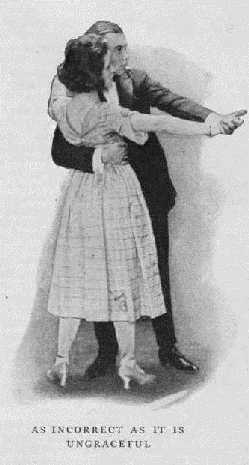
The Rebellion
In history there have been several great periods when music was declared to be an evil influence, and certain restrictions were placed upon the dance and the music which accompanied it. But all of these restrictions were made by the clergy, who have never been particularly enthusiastic about dancing anyway. To-day, however, the first great rebellion against jazz music and such dances as the "toddle" and the "shimmy" comes from the dancing masters themselves. Realizing the evil influence of this type of music and dancing, the National Dancing Masters' Association, at their last session, adopted this rule: "Don't permit vulgar cheap jazz music to be played. Such music almost forces dancers to use jerky half-steps, and invites immoral variations. It is useless to expect to find refined dancing when the music lacks all refinement, for, after all, what is dancing but an interpretation of music?"Several of the large dance halls in the big cities are following the lead of the proprietor of one of them in Chicago, who, when he opened his establishment a few years ago, bravely advertised that no jazz music and no immoral dances would be allowed on his floor. His announcement was met with ridicule, but his dance hall has become the most popular one in Chicago. The place is crowded every evening, and yet nothing except waltzes and two-steps are allowed on the floor and absolutely no jazz music is tolerated.
That jazz is an influence for evil is also felt by a number of the biggest country clubs, which have forbidden the corset check room, the leaving of the hall between dances and the jazz orchestras--three evils which have also been eliminated fropm many municipal dance halls, particularly when these have been taken under the chaperonage of the Women's Clubs.
Still another proof that jazz is recognized as producing an evil effect is the fact that in almost every big industry where music has been instituted it has been found necessary to discontinue jazz because of its demoralizing effect upon the workers. This was noticed in an unsteadiness and lack of evenness in the workmanship of the product after a period when the workmen had indulged in jazz music.
Many people classify under the title of "jazz" all music in syncopated rhythm, whether it be the ragtime of the American Negro or the csardas of the Slavic people. Yet there is a vast difference between syncopation and jazz. To understand the seriousness of the jazz craze, which, emanating from America, has swept over the world, it is time that the American public should realize what the terms ragtime and jazz mean; for the words are not synonymous, as so many people suppose.